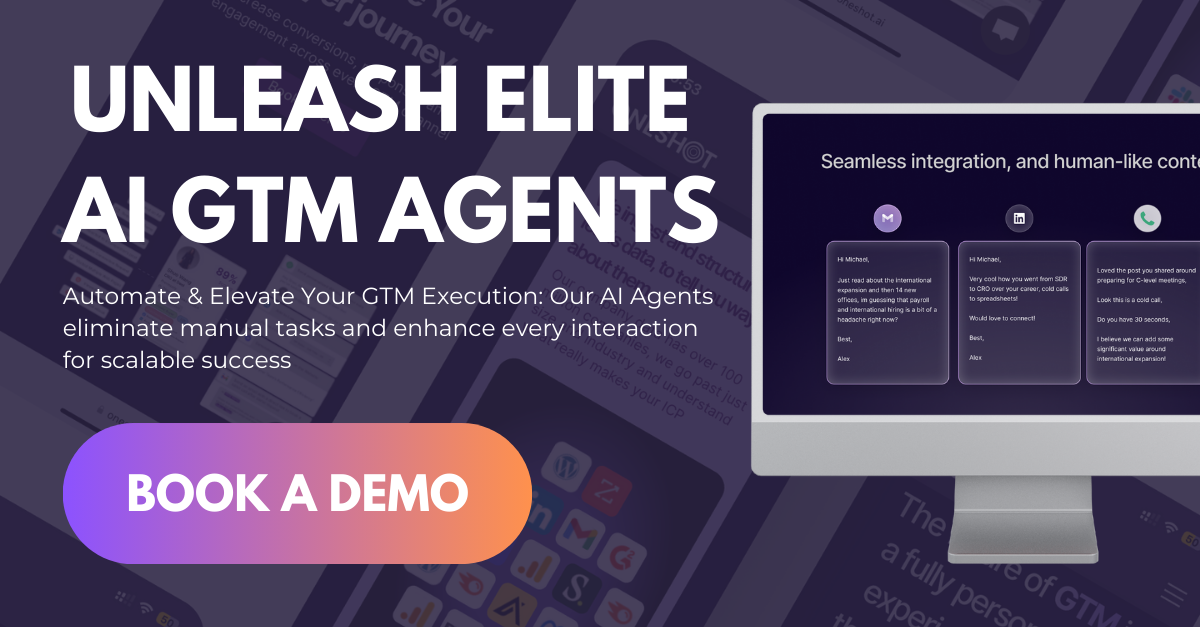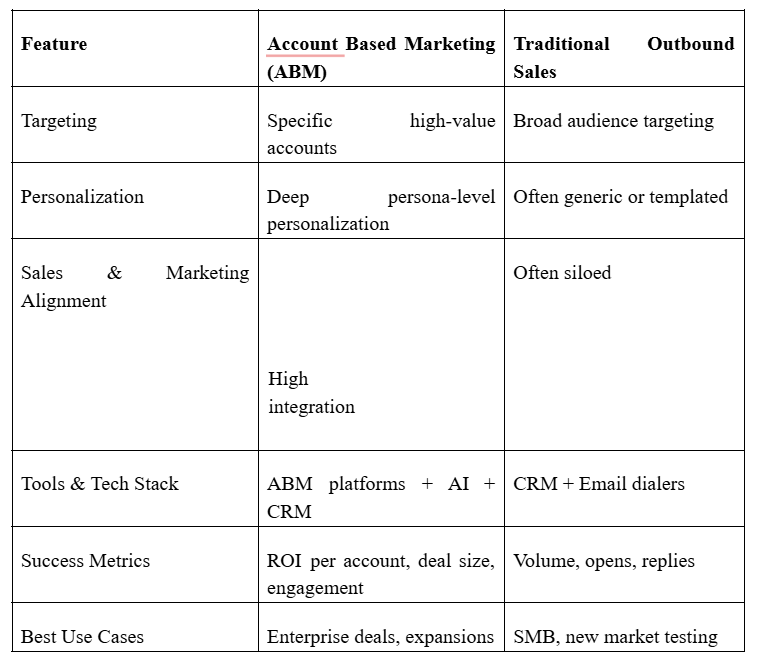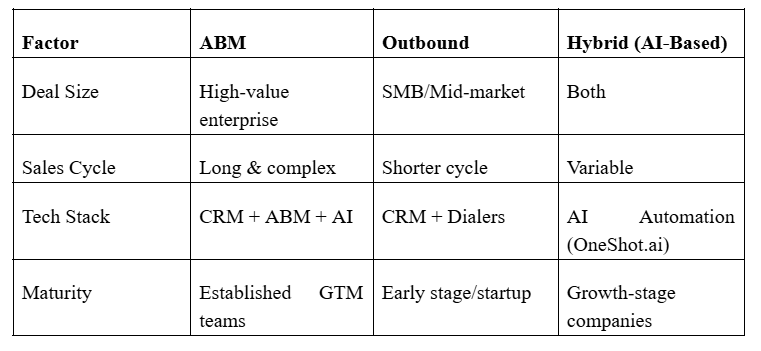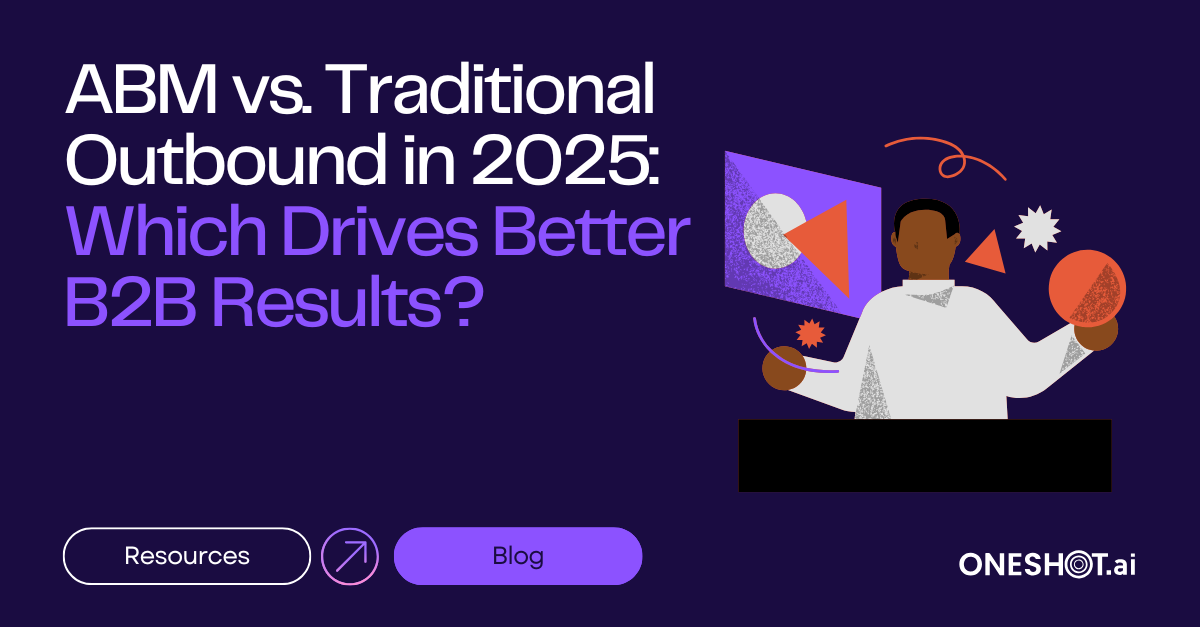ABM vs. Traditional Outbound: Which Wins in 2025?
In the ever-changing landscape of B2B selling, the distinction between Traditional Outbound approaches and Account-Based Marketing (ABM) blurs further – particularly in 2025. Both have strengths. Both have weaknesses. And with the emergence of AI-powered platforms like OneSshot.ai, the future of sales is not about one being better than the other – it’s about being smart.
Here, we will compare ABM with outbound marketing on personalization, scalability, ROI, and alignment with today's buyer behavior. We’ll discuss how platforms such as OneShot.ai are revolutionizing traditional ways with AI Sales Automation and what you should know to remain competitive.
See how OneShot.ai revolutionizes outbound sales with automation.
What is Account-Based Marketing (ABM)?
Account-Based Marketing (ABM), is a targeted tactic that aims at high-value accounts instead of broad market segments. Rather than casting a wide net, ABM creates in-depth relationships with a limited number of prospects – usually enterprise buyers.
Over the past decade, ABM has undergone significant transformation. With data-rich targeting and AI-driven personalization, it has become a predictable, ROI-focused model for sales.
Major Advantages of ABM:
- High-degree of personalization at the account and persona levels
- Better sales and marketing alignment
- High conversion rates for complex, long-cycle B2B deals
“ABM has a 97% ROI lift over traditional marketing.” – MarketingProfs
What is Traditional Outbound Sales
Traditional Outbound Sales is the slower, more traditional way: cold calling, cold emailing, bulk mass messaging on LinkedIn, and/or generic pitches sent to an indiscriminate list of people. This has always been the sales model for decades; however, this approach is quickly being outpaced by a modern buyer's expectations.
Most SDRs depend on standard outreach channels such as cold emails, telephone calls, direct mail, and generic, broad campaigns to engage prospects. Yet they are no longer delivering. Teams face major hurdles such as declining reply rates, quickly expired contact information, a lack of authentic personalization, and the ineffectiveness of "spray and pray" strategies that do not connect.
This has resulted in an expanding issue within the industry – what has been termed the "2% Reply Rate Dilemma." With hundreds of cold emails sent each day, SDRs find it difficult to get even basic engagement, emphasizing the need for a more intelligent, more effective approach to outreach.

Key Differences Between ABM and Traditional Outbound

What’s Changing in 2025? The Trends You Can’t Ignore
Sales in 2025 is not about who can mail out the most emails – it’s about who can be most relevant, quickly.
Top Trends
- AI for Sales Prospecting
Mckinsey: “30% of sales activity will be automated by 2025”
Gartner: “75% of B2B businesses will leverage AI applications for pipeline generation”
- Hyper-Personalization at Scale
Say goodbye to guesswork. AI facilitates data-driven messaging at a fraction of the cost.
- Fading Away of Manual SDR Work
Increasingly, more businesses are automating mundane tasks, mitigating burnout, and boosting effectiveness.
- MarTech + RevOps Integration
Sales and marketing aren’t isolated silos anymore – they’re merging into cohesive revenue teams.
Fuel the future of your outbound with AI – start using OneShot.ai today!
Which Strategy Performs Better in 2025?
Let’s break it down by real-world performance:
ABM in 2025
In 2025, Account-Based Marketing (ABM) remains a proven and extremely powerful strategy for reaching high-value accounts. Among the greatest benefits is the 2-3 times greater engagement with target accounts than with standard outreach tactics.
ABM also provides measurable ROI, frequently linked directly to larger deal sizes, making it an attractive strategy for sales and marketing teams that are keenly interested in efficiency and effect. In addition, the extensive account research that is used to drive ABM strategies usually translates into substantially increased win rates, since messaging and solutions are customized to meet the unique needs of individual accounts.
However, these benefits come with trade-offs. ABM remains resource-intensive, requiring close coordination between teams and consistent effort. Without the assistance of AI and automation, it may be cumbersome and time-consuming to scale ABM, especially in small teams or for large account numbers.
Outbound in 2025
Outbound strategies in 2025 continue to be crucial for demand generation, particularly for firms looking to engage a great number of prospects within a short time. Outbound high volume is perfect for speedy outreach, new messaging experimentation, and probing entry into new, untapped markets.
However, this approach often sacrifices personalization, resulting in low engagement rates. Additionally, manual workload can cause SDR burnout and turnover, which leads to operational inefficiencies.
That's where OneShot.ai Scaling Agent comes in with a game-changer—by tying together the wide coverage of outbound with the accuracy and relevance of ABM, it allows teams to engage with more accounts without sacrificing the customized touch that delivers results.

The Hybrid Future: AI-Driven ABM & Outbound Convergence
Welcome to the best of both worlds. In 2025, the best go-to-market playbook will no longer choose between traditional outbound or expensive resource-heavy ABM but will combine the precision of ABM and the scalability of outbound - the catalysts for this being AI.
One Shot.ai is riding the wave of change using intelligent automation to help teams create quality engagement at scale. After all, with intelligent AI handling the labor of research, personalization, and delivery, sales teams can focus on what matters; building authentic relationships and closing business.
OneShot.ai fills that gap with five built-in AI agents, one for each of the distinct challenges in today's outbound process. The Persona Agent does in-depth ABM research, the Insight Agent creates super-relevant, personalized messaging, the Channel Agent handles multi-touch across email, phone, and social, and the Scaling Agent optimizes for quantity without sacrificing quality.
Meanwhile, the Data Agent consistently enriches contact information in real-time, thus helping lower bounce rates and improve targeting.
Case Study:
The results speak for themselves: a SaaS company recently closed four enterprise deals in 60 days leveraging OneShot.ai's Insight and Persona Agents— tripling conversion rates while reducing outreach time in half.
Choosing the Right Strategy for Your Business
Not every business needs a full-scale ABM program or high-volume outbound. Here’s a quick decision matrix:

Recommend Tools for Success in 2025
For ABM (Account-Based Marketing):
- Terminus - Targeting + Reporting
- Demandbase - Intent Data + Orchestration
- HubSpot ABM - CRM + Marketing
For Everything Outbound:
- Apollo - Contact Data
- Outreach / Salesloft - Email + Call sequencing
For AI RT Hybrid:
- OneShot.ai - ABM + Outbound fused with AI (all above integrated)
Want to future-proof your outbound? Book a OneShot.ai personalized demo.
Verdict: ABM, Outbound. Or Fusion?
By 2025, the most enlightened go-to-market organization knows that choosing between ABM and Outbound is no longer a question – it's about strategically combining the two. ABM provides the accuracy to target high-value accounts, and Outbound provides the volume to reach more markets at scale and speed.
The enabler in this mix is AI, which allows for delivering personalized, multi-touch campaigns at scale without drowning sales teams. Looking ahead, forecasts indicate that by 2026, more than 80% of successful B2B sales teams will implement a hybrid model fueled by AI to remain competitive.
Transform your outbound approach with OneShot.ai and become part of the next wave of smart selling.
Expert Insights
- Alex Greene, Vice President of Sales @ SaaSCo:
"Before adopting OneShot.ai, our SDRs spent 60% of their time performing account research. NOW they only focus on conversations that convert."
- Tina Lin, ABM Strategist & LinkedIn Top Voice:
“AI in ABM is no longer an option. It is now the only way to scale relevancy.”
See how real sales leaders use OneShot.ai to scale personalization.
Conclusion
In 2025, the decision isn’t ABM or Outbound –It’s about uniting the best of both, smartly.
With AI-powered platforms such as OneShot.ai, scale outreach without becoming irrelevant, automate the grunt work, and reach the right buyers at the right moment.
Time to future-proof your sales strategy?
Begin Scaling Smart Outreach with OneShot.ai – Schedule a Demo
FAQs
1. What is the key difference between ABM and traditional outbound marketing in B2B sales?
Answer:
The key difference is that Account-Based Marketing (ABM) targets specific high-value accounts with personalized content, while traditional outbound marketing relies on broad outreach to a large audience through emails, cold calls, or ads. In 2025, ABM is gaining traction for its higher ROI and alignment with buyer intent.
2. Why is ABM considered more effective than traditional outbound campaigns in 2025?
Answer:
In 2025, ABM is more effective because it leverages data-driven personalization, tighter sales-marketing alignment, and AI tools to engage decision-makers at key accounts. This approach results in higher conversion rates, shorter sales cycles, and better customer retention compared to generic outbound tactics.
3. Can small businesses use ABM instead of traditional outbound strategies?
Answer:
Yes, small businesses can adopt a scaled-down version of ABM, often referred to as “lite ABM” or “programmatic ABM.” By focusing on a select group of high-fit leads and using affordable AI tools or CRM integrations, small teams can achieve better engagement without the cost of mass outbound campaigns.
4. How do AI tools enhance ABM and outbound marketing in 2025?
Answer:
AI tools in 2025 optimize targeting, personalize messaging at scale, and automate outreach sequences for both ABM and traditional outbound. In ABM, AI helps identify intent signals and account insights. In outbound, it improves email deliverability, lead scoring, and timing to boost response rates.
5. Which strategy—ABM or traditional outbound—has a higher ROI in 2025?
Answer:
ABM generally delivers a higher ROI in 2025 due to its laser-focused targeting, personalized content, and stronger alignment between marketing and sales. While traditional outbound may bring faster reach, ABM typically yields better quality leads and long-term business relationships.
Still have questions? Ask our experts at OneShot.ai






.png)


